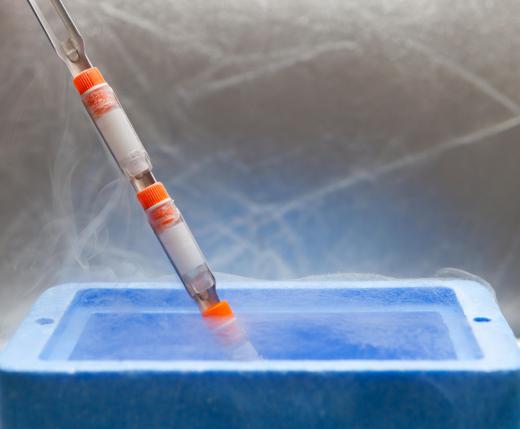What Is the Leidenfrost Effect?
 Mary McMahon
Mary McMahon
The Leidenfrost effect is a physical phenomenon that happens when a liquid is exposed to an extremely hot substance. The liquid in immediate contact with the heat vaporizes, and the vapor creates an insulating layer that slows the rate of evaporation and boiling, allowing the remaining liquid to hover. A classic example can be seen in the kitchen, where a cook might flick droplets of water into a pan to test the temperature. If the pan is hot enough, the beads of water will appear to skate across the bottom of the pan on a bed of vapor rather than evaporating immediately from the heat.
This effect is named for Johann Gottlob Leidenfrost, who described the phenomenon in the 1700s. Researchers in the 1800s followed up on his work and confirmed the findings. In the lab, the Leidenfrost effect is sometimes used for demonstrations and lab jokes; one potentially dangerous display involves dipping wet fingers in a bath of molten lead. The water on the fingers vaporizes and insulates them long enough to allow the experimenter to pull them back out again.

The physics behind the Leidenfrost effect are relatively straightforward. When liquid heats rapidly as a result of contact with something extremely hot, it forms a vapor layer. Vapor does not conduct heat very well, so it acts as a barrier between the heat of the pan and the remaining liquid. The droplets might appear to skim on the surface as the vapor drifts. Eventually, it steams away, as does the rest of the water.

In addition to being a topic of interest and entertainment in the lab, the Leidenfrost effect also has some practical applications. Researchers have demonstrated, for example, that this effect could be used for cooling mechanisms. Water droplets can be induced to run up a very hot grating with the help of the Leidenfrost effect, and this could drive a cooling system to help lower temperatures in an extremely hot system.
One consequence of the Leidenfrost effect is that water and other liquids can actually take longer to boil if conditions are too hot. Other demonstrations of the Leidenfrost effect involve playing with liquid nitrogen and other potentially dangerous materials. It is important for people to observe proper safety precautions in these demonstrations, because there is a narrow margin of error. Dipping one's fingers into molten lead, for instance, can cause severe burns if they are left in for too long.
AS FEATURED ON:
AS FEATURED ON:












Discussion Comments
@candyquilt-- I agree with you. Moreover, for this experiment to work, the heat of the lead needs to be just above the melting point. If it's higher than that, then the experiment might not work and might cause burns. Also, if there are any spots on the hand that are not wet, they will get burned.
An experienced adult who is very knowledgeable about science can probably do it to show the Leidenfrost effect safely. There have been a few TV science shows where they have done this experiment successfully. I personally would prefer showing one of those shows to kids rather than doing it myself.
I don't think I would ever do an experiment where I have to dip my fingers into molten lead. I realize that the water on my hands will protect me for a very short time, but there's no way I would take that risk. The barrier of vapor due to the Leidenfrost effect probably lasts for just a few seconds in this situation. But what if I don't pull my hand out fast enough?
I've seen this phenomenon so many times while cooking. I never knew that it had a name and I didn't realize the details of it either.
It usually happens to me by accident when I'm cooking with a hot pan. For example, when I'm getting ready to throw some washed vegetables into a hot pain, a drop or two of water will land on the pan. The water drops move along for a while and then evaporate. I have seen it so many times but I never stopped to think why those water drops do not evaporate immediately on contact with the pan. Now I know why and how it occurs. Thanks!
Post your comments